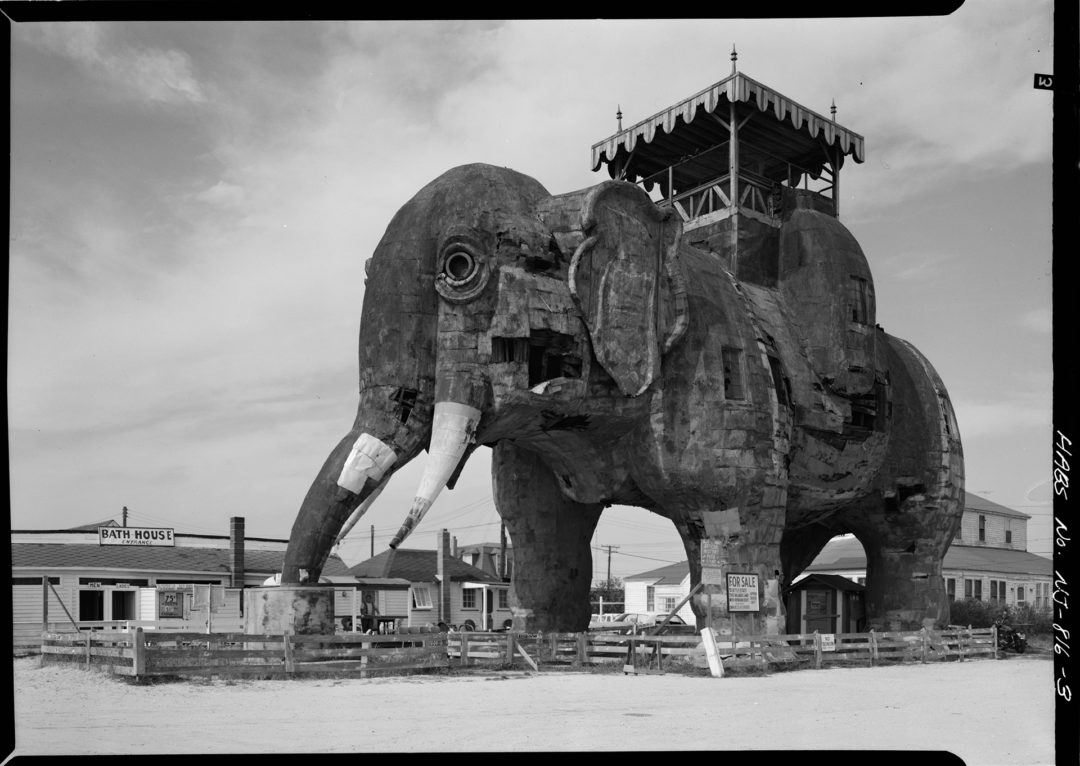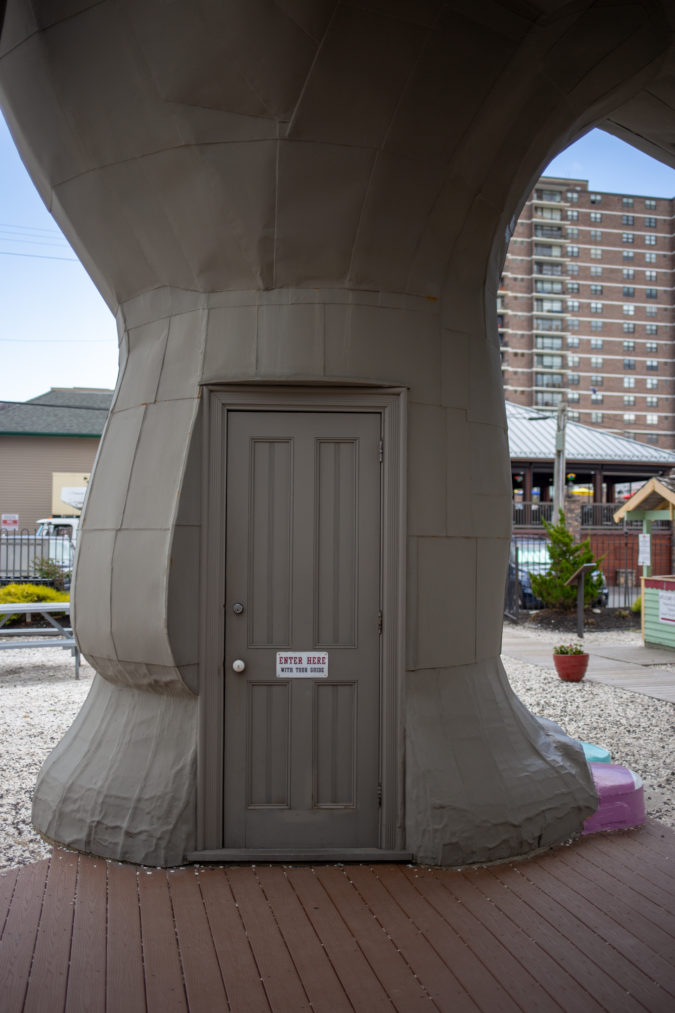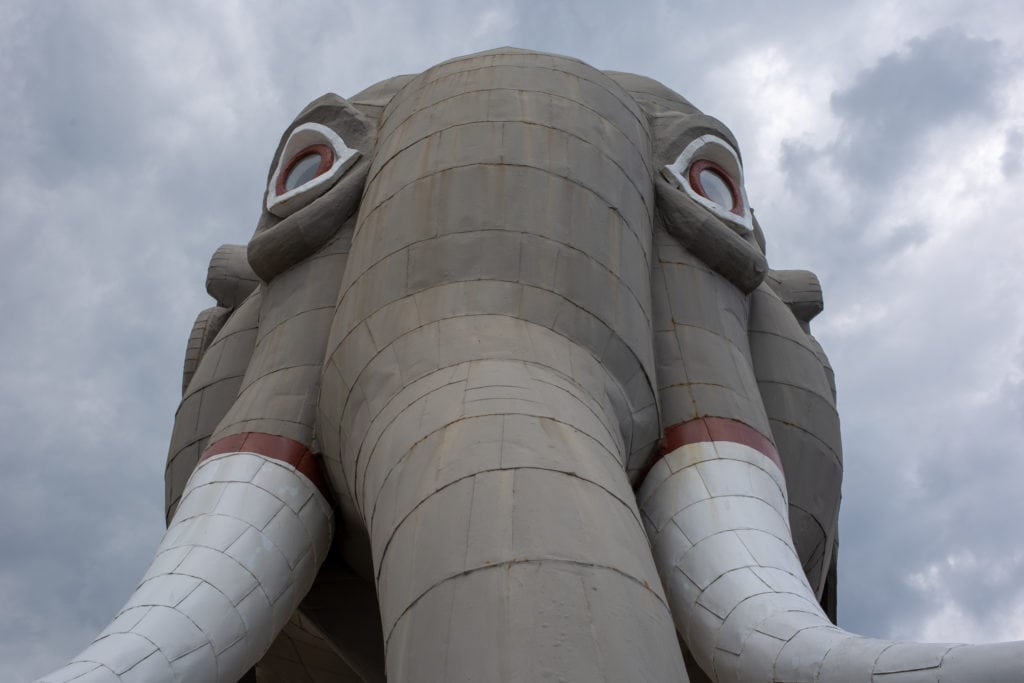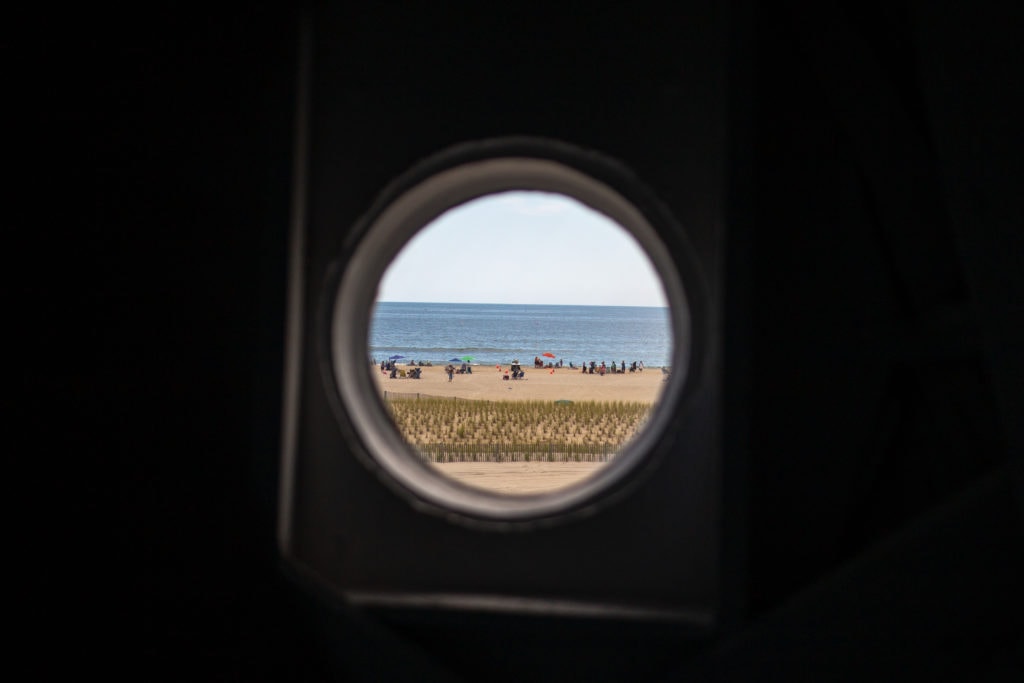Margate City may not be the most famous city on Absecon Island, but the small town on the Jersey Shore once known as South Atlantic City holds its own against its flashier neighbor to the northeast. Ventnor and Atlantic Avenues—names familiar to anyone who has played Monopoly—continue southwest into Margate City, home to Marven Gardens, the only property on the game’s board that is not located within Atlantic City. Margate City is best known for its largest resident, Lucy the Elephant, the oldest surviving roadside attraction in the country.
Originally called the Elephant Bazaar, Lucy was built by James Lafferty, a Philadelphia-based real estate developer, to help draw attention to his vacant, sandy lots in South Atlantic City. Inspired by Barnum and Bailey’s famous Jumbo the Elephant, Lafferty states in his 1882 patent application: “My invention consists of a building in the form of an animal, the body of which is floored and divided into rooms … the legs contain the stairs which lead to the body.” Lafferty added that the building “may be in the form of any other animal than an elephant, as that of a fish, fowl, etc.”
-
Photo: Alexandra Charitan -
Photo: Alexandra Charitan -
Lucy even has a tongue. | Photo: Alexandra Charitan -
Photo: Alexandra Charitan -
Photo: Alexandra Charitan -
Lucy has had several different howdahs throughout the years. | Photo: Alexandra Charitan
Although the patent gave him the exclusive right to make, use, or sell zoomorphic buildings for seventeen years, Lafferty only built two other elephant structures. The Light of Asia, erected in nearby Cape May in 1884, was also used as a marketing ploy for a New Jersey real estate developer; it was torn down after just 16 years. The Elephantine Colossus, built in Coney Island in 1885, was twice the size of Lucy and contained seven floors of hotel rooms; it burned down in 1896. Despite the broad language in his patent, Lafferty never branched out beyond elephants, and 138 years later, Lucy is the last woman standing.
A progressive pachyderm
I first met Lucy on my way to Atlantic City back in October 2016. Just a few miles away, employees of the Trump Taj Mahal were on strike and a few weeks later the casino’s namesake would be elected as our 45th president. Lucy’s nails were painted both red and blue to signal that it was an election year—the Republican party might claim the elephant as their mascot but Lucy, who has seen 26 different presidents come and go, wasn’t taking sides.

I visit Lucy for a second time on a hot and sunny day in July—missing her 138th birthday celebration, held this year on July 20, by a few days. The first thing I notice is that her nails are freshly painted, turquoise and purple this time. “She gets a pedicure every year for her birthday,” tour director Marsha Gowdy explains. The color selection is crowd-sourced via Facebook.
Lafferty enlisted Philadelphia architect William Free to help design and construct Lucy. The final structure cost Lafferty between $25,000 and $38,000 (more than half a million dollars today). Lucy is six stories and 65 feet tall; she’s listed as the twelfth largest statue in the United States, half a foot shorter than the Christ of the Ozarks and the same height as Dinny the Dinosaur in Cabazon, California. She weighs in at 90 tons and comprises nearly one million pieces of wood, 200 kegs of nails, 4 tons of bolts and iron bars, and is covered in 12,000 square feet of tin.


Lucy—modeled after an Asian elephant—is actually male by design. All African elephants, both male and female, have tusks. But only some male Asian elephants have tusks and about 50 percent of females and a small percentage of males have small tusk-like teeth called tushes. Although we can’t ask her which pronouns she prefers, Lucy, despite her 22-foot-long tusks, is now referred to as she/her.
A summer home
Lucy wasn’t as good for business as Lafferty had hoped, and in 1887 he decided to sell all of his property in South Atlantic City (reincorporated as Margate City in 1909), including his famous elephant-shaped office. Anton Gertzen of Philadelphia purchased Lucy and the surrounding land, and it remained in the Gertzen family until 1970. No one knows for certain why, but Gertzen’s daughter-in-law Sophia christened the elephant “Lucy,” and the name stuck.
-
Photo: Alexandra Charitan -
Photo: Alexandra Charitan -
Photo: Alexandra Charitan -
Photo: Alexandra Charitan -
Photo: Alexandra Charitan -
Photo: Alexandra Charitan
After the Philadelphia Centennial International Exhibition in 1876, the Gertzens purchased the fair’s Turkish Pavilion. The building, which had stained glass windows and onion domes, was disassembled into numbered sections and moved to Margate City. It was restored and reconstructed behind Lucy, where it operated as a hotel, rooming house, and beer garden.
“The most common misconception about Lucy is that she was once a hotel,” says Gowdy. Lucy mostly functioned as a tavern and a standalone tourist attraction; back then, tours cost ten cents. Only one family has ever had the privilege of living inside of Lucy—in 1902 a doctor visiting from England leased the elephant from the Gertzens as his summer home, converting the space into four bedrooms, a dining room, kitchen, bathroom, and parlor.

Mirroring the decline of Atlantic City and its notorious casinos, Lucy fell into disrepair over the years. In 1962, the structure was condemned and threatened with demolition to make way for a new condo building. Local Lucy-lovers Josephine Harron and Sylvia and Edwin Carpenter formed the Save Lucy Committee in 1969 and they were able to raise the necessary funds to save the historic structure from the wrecking ball.
On July 20, 1970, it took eight hours to move Lucy two blocks southwest to the city-owned lot where she stands today. Lucy’s annual birthday party—held on the Saturday closest to July 20—is actually a celebration of her “rebirth,” Gowdy says.

Lucy was declared a National Historic Landmark in 1976 and she is beloved by Margate locals as well as the thousands of families who flock to the shore in the summer. “So many people have grown up with Lucy,” says Gowdy. “You bring your kids, and then you bring your grandkids.”
Sand and storms
Today, the greatest threat to Lucy’s well-being is the harsh, coastal weather. Constant sand-blasting means that Lucy has to be repainted every few years. In 2007, the howdah on her back was struck by lightning, and a 2009 wind storm damaged her tail. Remarkably, Lucy weathered 2012’s Superstorm Sandy and emerged relatively unscathed. “Sandy just got her feet wet,” says Gowdy.


Visitors enter “the only elephant in the world you can walk through and come out alive” through a door in her back leg. A narrow spiral staircase opens up into the main room, which contains photos and artifacts from the unique structure’s history. “People are always surprised at how big it is inside,” says Gowdy.
Lucy is available to rent for weddings, bar mitzvahs, corporate events, class reunions, or birthday parties. “Whatever you can dream up, Lucy can do,” says Gowdy.
A glimpse of the Atlantic Ocean can be had through Lucy’s right eye (the view from the left is now obscured by a building). Another staircase takes visitors to the top of Lucy’s back and up into her howdah carriage, which offers a 360-degree view of the beach and surrounding, manicured streets. Margate City is so proud of their pachyderm that her painted portrait adorns the city’s water tower nearby.
-
The view from Lucy’s right eye. | Photo: Alexandra Charitan -
The interior is now a small museum with Lucy artwork and artifacts. | Photo: Alexandra Charitan -
Photo: Alexandra Charitan -
Photo: Alexandra Charitan -
Lucy is located on the shore of the Atlantic Ocean. | Photo: Alexandra Charitan -
The view of Margate City from the howdah. | Photo: Alexandra Charitan -
A snack for Lucy. | Photo: Alexandra Charitan
We’re taking in the view and enjoying the cool ocean breeze when Gowdy recounts the time she was up in the howdah and spotted another famous piece of roadside kitsch driving down Atlantic Avenue. “I’m on top and I look out and see the Wienermobile drive by,” she says. Assisted by another tour guide, Gowdy flagged down the iconic vehicle. The driver received a tour of Lucy, and a history lesson.
The Wienermobile, the Longaberger Basket headquarters, the Big Duck, Twistee Treats and other important pieces of Americana may not have been built if Lafferty hadn’t dreamed big and decided to construct his real estate office as a larger-than-life elephant along the shore.
There’s no way to know how Lucy felt as she was introduced to a modern entry into the world of whimsy that she helped create, but I think she would be happy that she has inspired countless others to build up and out of the box.
If you go
Lucy the Elephant is open year-round but hours vary seasonally. There is no charge to visit the grounds or the gift shop. Guided tours are offered every half hour.


























